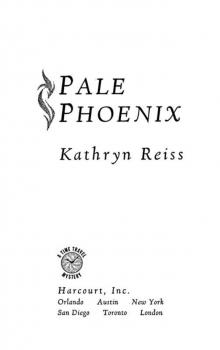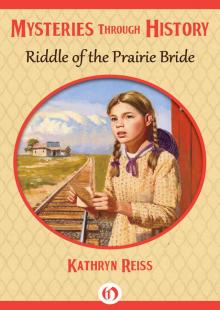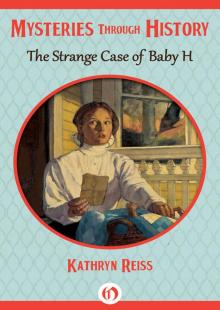- Home
- Kathryn Reiss
Riddle of the Prairie Bride Page 11
Riddle of the Prairie Bride Read online
Page 11
“Ending it?” Papa asked sharply. “Why, woman, our wedding date is only two weeks away! I’ve already arranged everything with the good Pastor Smiley.”
“You would have married me, even suspecting …?” Lucy’s voice trembled.
“I knew you would come clean by then,” Papa said gently.
“How could you know, Papa?” demanded Ida Kate. “How could you know that Caroline—I mean Lucy—would tell you who she really was?”
“Because this young charlatan is a woman of fine character,” Papa said, his voice warm. “And she can turn plain mush into something delicious. And kill a rattler with a single blow. And bring laughter into our house again. And sing like an angel.” His dark eyes sparkled at Lucy as he continued.
“She comes from a family of abolitionists, even as I do, and she knows what’s right and what’s wrong. She would never take her wedding vows under a dead woman’s name. She just wouldn’t be able to, plain and simple.”
“No, I wouldn’t,” Lucy agreed. “But I was so miserable about having to confess, so sad that we wouldn’t be able to marry … I was just hanging on to my story as long as I could. It was very selfish of me, and I apologize to you both most humbly.” She took a deep, shuddering breath, staring for a long minute at the swirling white outside the windows. “I do feel better now, having it all off my chest, and I will pack my bags and leave as soon as the rails are clear again.”
“Nonsense,” Papa said. “Poor Caroline is dead, God rest her soul. But Lucy Dotson is alive and well, and these two children need a mother, and I certainly need a wife … and I especially need a wife named Lucy Dotson.”
Lucy turned from the window and met Papa’s gaze as he left his chair and knelt in front of her.
“Lucy, will you do me the great honor of marrying me?” he asked.
And as Lucy, laughing and crying, leaned forward to embrace him, Ida Kate started to laugh and cry as well. Her cheeks glowed with welcome warmth despite the howling cold outside, and she moved—with Hanky in her arms—into their hug.
Later that night they all sat together at the trestle table. The blizzard outside seemed to be tapering off, and the wind had dropped. Lucy concocted a quick soup of onions and potatoes in broth, and Ida Kate mashed a potato with milk for Hanky. She also opened one of the jars of applesauce from the storeroom for all of them to share.
They ate their simple meal in the glow of the lamps. Hanky, refreshed from his nap, sat on Papa’s lap. Papa alternated between spooning soup into his own mouth and aiming bites of mashed potato at Hanky’s. Lucy sat opposite Papa, pale and quiet—as if the afternoon’s confession had left her feeling weak. But a smile played around her lips, and her eyes were bright.
Ida Kate looked around at them all and thought, This is my family.
A happy thought indeed.
But suddenly Lucy’s brow furrowed. “What will people say?” she murmured. “How will I ever explain?”
“What do you mean?” To Ida Kate it seemed all their problems were over now that the questions had been answered, the lies revealed, explained—and forgiven. What could trouble them now?
Lucy stared into her soup bowl as if it might hold a solution to her worries. Then she raised her head. “Oh, Henry! What shall I do? Everyone in Hays City and for miles around expects you to be marrying Caroline Fairchild! How am I ever going to explain myself to the Ruppenthals, and to people like Miss Butler, and—good heavens—to Pastor Smiley himself?” She set down her spoon and spread her hands wide. “How will I ever be accepted by the good people of Hays?”
Papa quirked a dark eyebrow at her. “That, my dear, will no doubt be your next big adventure.”
Pastor Smiley was at his officious best. He even managed to smile at the couple standing before him. Two weeks after the blizzard, the weather was balmy again, a fine spring day, though humps of dirty snow still lay about the town, melting slowly in the Kansas sun. The courthouse was full of friends and neighbors and townspeople who just wanted a chance to meet the impostor bride. Before the ceremony started, murmurings and hushed remarks filtered through the crowd. Ida Kate, sitting on the front bench with Hanky in her lap, couldn’t help but overhear: “Can you imagine?” “Now she says her name is Lucy Dotson!” “Well, I never!” “And what about that baby?” “I knew all along that something was amiss—didn’t you?” “I say she’s nothing but an adventuress!” “Well, madam, I say there’s never been a lovelier bride, and look how Mr. Deming is grinning fit to beat the band! He’s never been happier.”
Ida Kate glanced up at Lucy to see how she was taking all this, but the bride’s eyes were on her groom. Their hands were clasped.
Martha, sitting across the aisle with her whole family, waggled her fingers at Ida Kate. Miss Butler sat primly with her parents. And at last Pastor Smiley began. He spoke of the holy state of matrimony and his hopes that this union would be fruitful. He said, “Dost thou, Lucy Dotson, take Henry Clay Deming to be thy lawfully wedded husband?”
“I do.” Lucy’s voice was clear and full of joy.
Ida Kate, listening to Lucy’s words and Papa’s response, felt full of wonder and amazement at the way this riddle had been solved. Now there was no impostor—there was only Lucy, the real Lucy, and Ida Kate couldn’t wait to get started on their new life together.
“You may now kiss the bride,” Pastor Smiley said, and Ida Kate, watching with a big smile on her face and jostling baby Hanky on her shoulder, felt Mama looking down at them with approval. Many blessings on this family, Mama was saying. And Ida Kate thought it quite likely that the real Caroline Fairchild was up there with Mama—looking down on them all right now—and smiling, too.
1878
GOING BACK IN TIME
LOOKING BACK: 1878
Although Ida Kate’s story is fiction, women really did travel west in the nineteenth century to become brides to men they knew only through letters. “Heart and hand” newspapers in the eastern states printed letters from men who had established homesteads in the West and longed for the help and companionship of a wife. One bachelor’s letter in 1853 declared, “I love to think of thee and think that thare is a day a coming when wee will be happy together. I live a lonsom and desolate life.”
Sometimes a whole group of men would hire a helper, called a jobber, to go east and bring back a shipload or train car of women wanting to marry. One report in 1844 described the arrival of a Mississippi River steamboat carrying 41 women. Even before the brides had left the boat, men on shore were calling to them: “Miss with the blue ribbon on your bonnet, will you take me?” and “Hallo thar, gal with a cinnamon-colored shawl! If agreeable, we will jine!”
These women must have decided that life with an unknown man in possibly primitive living conditions was still better than remaining a spinster. Unmarried women had few options for employment, as Caroline Fairchild and Lucy Dotson discovered. Some unmarried women found work in factories or as school-teachers, but most spent their lives with parents or married siblings, helping to care for nieces, nephews, and the elderly.
Marriage offered women security and a home and children of their own. In the nineteenth century, love was rarely the reason for marriage—though often love grew between a couple after they had married. Instead, both men and women married for companionship, social standing, children, and help in running a home and farm or business.
Many men on the frontier who wanted to marry could not find wives, however. Taming the West was considered a job for men, so there were few single women among the early settlers. In the mid-1870s, for example, there were ten times more men than women in Kansas!
Settlers began heading west in large numbers in 1862, when the government passed the Homestead Act. This law gave 160 acres of land to anyone who paid a $10 filing fee and farmed the land for five years. Ida Kate’s father would have been one of thousands who flooded into Kansas, Nebraska, Minnesota, and the Dakotas after the Civil War to claim land of their own.
These settlers
included Americans from the East—both white people and freed slaves—as well as immigrants from abroad, like Martha’s stepmother. Many were farmers or ranchers, but others were shopkeepers, blacksmiths, wagon makers, dressmakers, saloon owners, innkeepers, doctors, ministers, and teachers who settled in the small towns that dotted the railroad lines.
In the eastern part of the prairies, settlers built log cabins. But in the western prairies, where trees were scarce, some settlers lived in dugouts—homes hollowed out of hills. Others, like Ida Kate’s family, built sod houses out of “prairie brick,” heavy blocks of earth cut straight from the prairie.
Homesteaders on the plains faced fierce challenges—tornadoes, grass fires, hailstorms, floods, and blinding blizzards. Some years vast, crackling black clouds of grasshoppers would drift in on the winds, ruining the crops and trying to eat everything else in sight.
Yet the settlements and the settlers managed to hold on. In 1867, the year Ida Kate and her parents moved west, railroad track was just being laid through Kansas. To protect the railway builders from Indian attack, Fort Hays was built along Big Creek, and the town of Hays City sprang up nearby. At first Hays City was just a shantytown of flimsy buildings and tents at the end of the railroad line, and it teemed with “Wild West” adventurers and outlaws. But the railroad soon brought farmers, businessmen, cowboys, and soldiers to the area. As newcomers flooded in, however, the original inhabitants of the prairie were driven out. The buffalo disappeared, and Indian tribes were forced to move south and west. Most of the outlaws and adventurers moved further west, too, following the frontier.
By 1878, the year of Ida Kate’s story, Hays City had become a real town centered along one wide street a few blocks long. Like most prairie towns, it was the hub of frontier society. People from miles around would meet at the general store or at church. The town sometimes seemed rough and lawless, but most frontier families loved its bustle and energy. Farm women tried to go into town every few weeks for shopping, sewing circles, church picnics, and even literary societies.
Most frontier girls and women, like Ida Kate and Lucy, were used to the hard work involved in housekeeping and farming. But women raised in cities or in wealthy families, like Caroline Fairchild, would have found life on the prairie more challenging. Such women were no strangers to hard times, however. The decades following the Civil War were difficult all over America, but especially in the South, where many once-wealthy families found themselves nearly penniless. Women who had been raised in luxury, like Caroline, had to find jobs for the first time.
Many people desperate for work headed to the factories and mills of Massachusetts, just as Caroline and Lucy did. Factory work was hard and dangerous, with long hours and meager pay, but it was steady work. Children were paid very low wages, and women earned only slightly more—less than half of what men earned. Because of this, greedy factory owners preferred to hire women and children instead of men. Unmarried women workers lived in cramped, crowded boardinghouses near the mills.
The shoe factory in Lynn, Massachusetts, where Caroline and Lucy worked, was a huge, smoky room where 200 girls and women tended 500 roaring, steam-powered sewing machines. The workers painted glue onto leather, gummed down the edges of seams, and hammered the soles of shoes and boots into place. If their bare hands touched the shoe dyes, their fingernails would rot off from the chemicals. Accidents—explosions, fires, and malfunctioning machines—were all too common.
In the 1870s, the noisy factory towns and bustling cities of the East seemed overcrowded, hopeless places to many. These people—like Ida Kate’s family, like Caroline and Lucy—looked to the West, where open land was still plentiful and dreams could stretch across grassland, deserts, and mountains.
GEOGRAPHICAL NOTE
Castle Rock is a large, dramatic natural rock formation approximately 40 miles west of Hays, Kansas. For the purposes of this story, its location has been moved closer to the Deming farm to allow the Demings to travel there for a picnic. Settlers living close to Castle Rock visited frequently, marveling at its towering height rising from the flat prairie. Castle Rock is still a popular tourist attraction today.
About the Author
Kathryn Reiss lives in a rambling nineteenth-century house in Northern California, where she is always hoping to discover a secret room or time portal to the past. She is the author of many award-winning novels of suspense for children and teens, among them Time Windows, Dreadful Sorry, Paint by Magic, PaperQuake, and Sweet Miss Honeywell’s Revenge. When not working on a new book, she teaches English and creative writing at Mills College and enjoys spending time with her husband, seven children, and many cats and dogs.
All rights reserved, including without limitation the right to reproduce this ebook or any portion thereof in any form or by any means, whether electronic or mechanical, now known or hereinafter invented, without the express written permission of the publisher.
This is a work of fiction. Names, characters, places, events, and incidents either are the product of the author’s imagination or are used fictitiously. Any resemblance to actual persons, living or dead, businesses, companies, events, or locales is entirely coincidental.
Text Copyright © 2001, 2010 by Kathryn Reiss
Map Illustration by Paul Bachem
Line Art by Laszlo Kubinyi
Cover design by Amanda DeRosa
ISBN: 978-1-4976-4651-3
This edition published in 2014 by Open Road Integrated Media, Inc.
345 Hudson Street
New York, NY 10014
www.openroadmedia.com
MYSTERIES THROUGH HISTORY
FROM OPEN ROAD MEDIA
Available wherever ebooks are sold
Open Road Integrated Media is a digital publisher and multimedia content company. Open Road creates connections between authors and their audiences by marketing its ebooks through a new proprietary online platform, which uses premium video content and social media.
Videos, Archival Documents, and New Releases
Sign up for the Open Road Media newsletter and get news delivered straight to your inbox.
Sign up now at
www.openroadmedia.com/newsletters
FIND OUT MORE AT
WWW.OPENROADMEDIA.COM
FOLLOW US:
@openroadmedia and
Facebook.com/OpenRoadMedia

 Pale Phoenix
Pale Phoenix Riddle of the Prairie Bride
Riddle of the Prairie Bride The Strange Case of Baby H
The Strange Case of Baby H